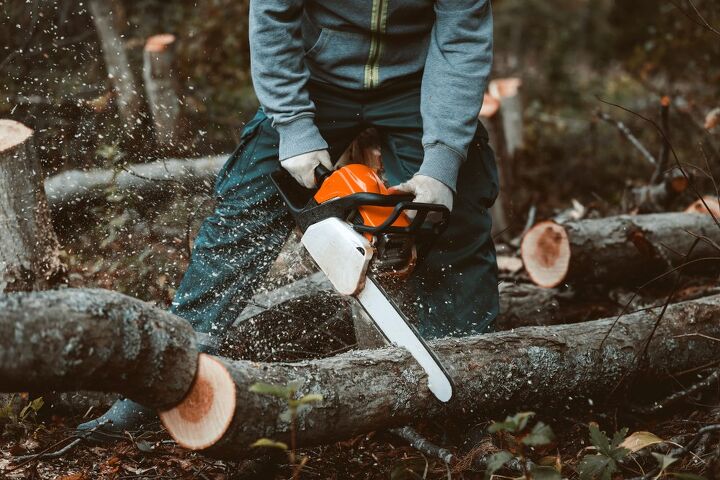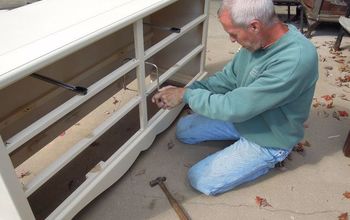The 5 Best Chainsaws on the Market Right Now

By Corrie Pelc
A chainsaw is one of those tools a lot of homeowners may not realize they actually should have in their shed. Most times, people imagine a chainsaw as just being needed by lumberjacks and by those who have forests in their backyard they need to maintain. That's not true — a chainsaw can trim bushes and hedges a lot quicker and easier than electric hedgers. And if you do have trees on your property, a chainsaw comes in handy when you want to trim down large branches or if any part of a tree falls down during a storm.
If you don’t have a chainsaw yet in your home landscaping tool kit, we’re here to help you find the best one for your needs with this list of the best chainsaws on the market.
Top Picks
-
Best Gas-Powered Chainsaw: Poulan Pro PR4218 18 in. 42cc 2-Cycle Gas ChainsawA gas-powered chainsaw with a lot of perks and reduced emissions.
-
Best Corded Electric Chainsaw: Oregon CS1500 18-inch Self-Sharpening Corded Electric ChainsawA corded electric chainsaw that self-sharpens and has safety in mind.
-
Best Battery-Powered Chainsaw: Greenworks Pro GCS80420 80V 18-Inch Brushless Cordless ChainsawA battery-powered chainsaw that can handle just about anything a gas-powered one can.
-
Best Heavy Duty/Professional Chainsaw: Husqvarna 24-inch 460 Rancher Gas ChainsawA pricey gas-powered chainsaw that has lots of features worth the extra dollars.
-
Best Chainsaw for Under $100: Worx WG303.1 14.5 Amp 16-inch Electric ChainsawA great corded electric chainsaw that won't break the bank.
Types of Chainsaws
In general, there are three types of chainsaws based on how they are powered:
- Gas-Powered Chainsaws: These are your traditional chainsaws that run on gasoline. Gas-powered chainsaws are generally considered the best option for heavy-duty work, such as cutting down large trees, as they are normally more powerful than electric chainsaws. However, they are usually very loud, smelly due to the gas they use, and can be a lot heavier than other chainsaw types. And also important to keep in mind that not all cities and towns allow you to use gas-powered chainsaws — or other gas-powered landscaping tools, for that matter — so check your city’s ordinances before purchasing one.
- Corded Electric Chainsaws: Compared to a gas-powered chainsaw, corded electric chainsaws are usually a lot quieter and lighter, plus there's no dealing with refilling gas. These chainsaws are best suited for lighter jobs, like cleaning up hedges and smaller tree limbs. With a corded electric chainsaw, you do have to deal with a power cord, so you'll need an electrical outlet nearby.
- Battery-Powered Chainsaw: The battery-powered chainsaw is basically a corded electric chainsaw minus the cord. Although you can move a lot more freely, the battery won't last forever, so it will need to be recharged between uses.
Factors We Considered When Finding the Best Chainsaws
Knowing what makes for a great chainsaw is crucial in finding the right one for you. Here’s a look at the test factors we used when developing our list of the best-rated chainsaws:
- Price: With chainsaws available at many different price points, cost becomes an important comparison factor.
- Power Type: Is the chainsaw gas-powered, corded electric, or battery-powered?
- Weight: How much does the chainsaw weigh? The heavier the chainsaw, the more challenging it is to move around the yard and use for long periods of time.
- Engine Power: How powerful is the chainsaw’s motor? Power for chainsaw engines is generally measured in cubic centimeters (cc). A larger engine provides more power to the chainsaw, making it appropriate for cutting down trees, while a smaller engine offers less power, making the chainsaw better for things like garden and landscape clean-up. Another way engine power is measured is by Amp, which is the measure of the force of the electrical current of the tool, and volt, which is defined as the electric potential difference between two points.
- Chain Bar Length: The chainsaw bar is the long metal part that extends out from the chainsaw that the chain wraps around. This gives you an idea of how much a chainsaw can cut — smaller chain bar lengths are more suitable to hedges, while larger chainsaw bars can handle large trees. A chain bar length of between 14 to 18 inches is usually best as it covers just about everything.
- Start: How does the chainsaw start — is it a pull start or a push button?
- Bar and Chain Oiler: To perform well, a chainsaw needs oil for its bar and chain. Every chainsaw takes care of this through a fixed flow/automatic or adjustable oiler, which applies oil to the bar and chain while the chainsaw is in use.
- Chain Tensioning: Keeping the chain taught on the bar is crucial for getting max output from a chainsaw. Most chainsaws will offer either side-mounted or tool-free chain tensioning so the chain tension can be easily adjusted when sawing.
- Safety Features: There is no denying that a chainsaw can be a bit scary to operate at first. All of today’s chainsaws have lots of safety features, including things like kickback guards, chain brakes and catchers, guards, and other options.
- Warranty: What type of warranty is available from the manufacturer?
What’s the best chainsaw for the money? Let's find out!
Best Gas-Powered Chainsaw: Poulan Pro PR4218 18 in. 42cc 2-Cycle Gas Chainsaw
The Poulan Pro PR4218 18 in. 42cc 2-Cycle Gas Chainsaw is a great option for taking care of small to medium-sized jobs, such as cutting firewood and cleaning up fallen trees after a storm. The chainsaw uses Poulan's patented OxyPower technology that offers a lot of power while still using 20% less fuel and causing 70% less emissions, making it an environmentally friendly option. The chainsaw features an automatic oiler to keep the chain and bar well-lubricated during use, and access to the chain tensioning tool through tool-less access. Starting the chainsaw is a snap with its easy pull cord, while the advanced air filter system helps keep debris out of the filter to help extend the engine's life. The Poulan Pro PR4218 18 in. 42cc 2-Cycle Gas Chainsaw's safety features include an inertia-activated chain brake and reduced vibration handles to make it easier to grip onto the chainsaw when in use.
Pros
- OxyPower technology provides more power with less fuel use and emissions
- Easy to start
- SuperClean air filter system helps extend the engine's life
Cons
- Noisy when in use
- Gas required
- Will still have to deal with some emissions from this gas-powered tool
Best Corded Electric Chainsaw: Oregon CS1500 18-inch Self-Sharpening Corded Electric Chainsaw
Not only is the Oregon CS1500 18-inch 15 Amp Self-Sharpening Corded Electric Chainsaw easy to use and operate, but it also self-sharpens its chain with just the pull of a lever in 3-5 seconds, meaning you don’t have to sharpen the chainsaw manually. Designed to operate quietly, this chainsaw requires no gas — just plug it in and go. It starts with just the pull of a trigger, has an 18-inch bar that can handle the majority of jobs in your home yard, keeps the bar and chain slick with its automatic oiler, and has a tool-less chain tensioning system. The Oregon electric chainsaw is also made with safety in mind and includes a chain brake, low vibration design, and an ergonomic handle for added comfort when in use.
Pros
- Self-sharpens the chain in just a few seconds
- 18-inch guide bar can handle most jobs in a typical home yard
- Lots of safety features including chain break and low kickback and vibration design
Cons
- Has to be plugged in to work
Best Battery-Powered Chainsaw: Greenworks Pro GCS80420 80V 18-Inch Brushless Cordless Chainsaw
With almost 1,600 ratings and 4.5 stars on Amazon, there's no surprise the Greenworks Pro GCS80420 80V 18-Inch Brushless Cordless Chainsaw is our top pick for battery-powered chainsaws. With its generous 18-inch bar, this chainsaw can muscle through trees and limbs up to 34 inches in diameter. And its 2.0Ah battery provides enough power to make 150 cuts through 4-inch x 4-inch pressure-treated lumber on just one charge. The chainsaw features a brushless motor (a motor that uses only magnets to operate, making it more energy-efficient compared to a brushed motor) to provide the equivalent power of a 45cc gas engine in a battery-charged saw. The chainsaw features an automatic oiler, side-mounted chain tensioning, and a see-through window for the oil chamber so you can see when it needs to be refilled. And the cordless chainsaw takes safety into consideration with its low kickback bar and chain, wrap-around handle, and inertia-activated chain brake.
Pros
- Extremely lightweight
- Battery only takes 30 minutes to charge
- Four-year limited warranty on both the chainsaw and battery
Cons
- Battery needs to be charged between uses
Best Heavy Duty/Professional Chainsaw: Husqvarna 24-inch 460 Rancher Gas Chainsaw
If you need a chainsaw that can handle pretty much anything you throw at it, then you need the Husqvarna 24-inch 460 Rancher Gas Chainsaw. One of the best chainsaws for the money, this tough and powerful tool boasts a 24-inch chain bar and 3.62 HP X-Torq engine for not only amazing power, but it also uses less fuel and produces less emissions than other gas-powered chainsaws on the market today. Easy to pull-start, the chainsaw has a specialized system designed to reduce vibration levels and a combined choke/stop control to help eliminate the potential for engine flooding. This chainsaw comes with an adjustable oil pump so you can easily control how much oil is used to lubricate the bar and chain. The Husqvarna 24-inch 460 Rancher Gas Chainsaw also features a centrifugal air cleaning system to keep large debris from entering the air filter, which can help lengthen the engine's life.
Pros
- Generous 24-inch bar can handle just about everything
- Smart Start pull-start system makes starting the chainsaw easy
- LowVib System designed to reduce vibration levels
Cons
- Noisy
- Needs gas to work
- Gas-powered chainsaws will always have some emissions
Best Chainsaw for Under $100: Worx WG303.1 14.5 Amp 16-inch Electric Chainsaw
A starter chainsaw for those only looking for light-duty work around their backyard, the Worx WG303.1 14.5 Amp 16-inch Electric Chainsaw is an excellent option for under $100. Featuring a good-sized 16-inch chain bar, this chainsaw has an auto-tension system to keep the chain at the best tension for optimal performance (so you don’t have to figure it out yourself). It also takes care of oil greasing with its auto-lubrication system, and easily turns on and off with a switch. And you'll feel safe using this lightweight chainsaw — the Worx WG303.1 14.5 Amp 16-inch Electric Chainsaw features a quick-stop chain brake, full wrap front handle, rubberized rear handle, and metal spike bumpers that help cut down on kick-back when the chainsaw is doing its thing.
Pros
- Under $100
- Auto-tension and auto-lubrication systems keep the chainsaw running smoothly
- Lots of safety features
Cons
- Has to be plugged in to use — cord is only 14 inches long
Chainsaw Safety Tips
While at the word "chainsaw," visions of old horror movies may run through your mind, you can without a doubt operate a chainsaw safely. Here are some safety tips when operating your new chainsaw:
- Read the Manual — While this may seem pretty basic, so many people skip this step that it's worth mentioning. No matter what new tool you've just purchased, always take a few minutes to read through the included owner's manual so you can learn how to operate and take care of it safely and effectively.
- Wear Protection — When chainsaws are working, wood will be flying. Make sure to protect yourself with goggles for your eyes, a face shield and/or hat for your face and head, appropriate work boots for your feet, and long pants and long-sleeved shirts for your body.
- Protect Your Ears — Gas-powered chainsaws are loud. Make sure to protect your hearing with earplugs.
- Examine Before Use — Always check your chainsaw to make sure everything is properly working and does not look damaged. Make sure the handles are clean and dry and that the chain and bar lubrication system is working correctly.
- Always Use Proper Form — Always operate a chainsaw with two hands, no matter how light it is. Make sure your stance is well-balanced and you have nothing long or dangling that can get in the way or get caught up in the chainsaw. Know your surroundings so you don't trip over a hazard or cut into something you didn't want to. And beware of letting the cutting arm contact any objects or the ground, as this can cause a kick-back.
- Consider Taking a Safety Course — Some companies and organizations offer chainsaw safety courses. The extra time and money spent on one of these courses will help you stay safe and get the most out of your chainsaw.
Chainsaw Upkeep
A chainsaw is an investment, and like any investment, you want it to last for a long time. Here are some tips on keeping your chainsaw in top sawing condition:
- Learn the Manufacturer's Suggested Cleaning Tips — Remember our suggestion for reading the owner’s manual for safety’s sake? This is also suggested for keeping your chainsaw well-maintained. Read up on what the manufacturer recommends in terms of maintenance.
- Keep It Lubricated — Keeping the chainsaw bar and chain lubricated properly is vital for making sure the saw works well. If your chainsaw has an automatic lubricator, make sure the oil well is full. And if not, make sure the bar and chain are lubricated before each use.
- Stay Sharp — Unless your chainsaw has a self-sharpening feature, you’ll need to sharpen the chain every so often. Find out what the manufacturer suggests for when you need to sharpen the chain and stick to it.
- Keep It Clean — When not in use, store your chainsaw in a cool, dry place and preferably in its case, if it came with one.
Do you have a chainsaw that’s a great all-around landscaping tool for you? Tell us about it in the comments below!
Enjoyed the project?
Comments
Join the conversation
-
 Dee
on Dec 29, 2022
Dee
on Dec 29, 2022
I have a stihl chainsaw and it goes thru trees like butter/
-
-
 Melinda
on Apr 12, 2024
Melinda
on Apr 12, 2024
I've used different types of chainsaws for various tasks, and what works best really depends on what you need it for. For big jobs, you need a sturdy, powerful chainsaw. But these can be too much for smaller jobs or quick fixes around the house.
I've started using a mini chainsaw recently for these smaller tasks. It's been great because it’s so light and easy to use, especially for cutting small branches or pieces of wood. It’s also really handy for getting into tight spots where bigger chainsaws just can’t go. If you're looking for something that's easy to handle and won't tire you out, this might be a good choice.
-
































Frequently asked questions
Have a question about this project?